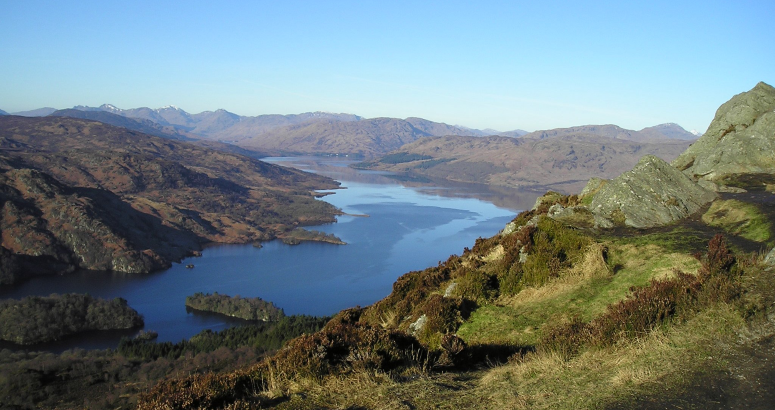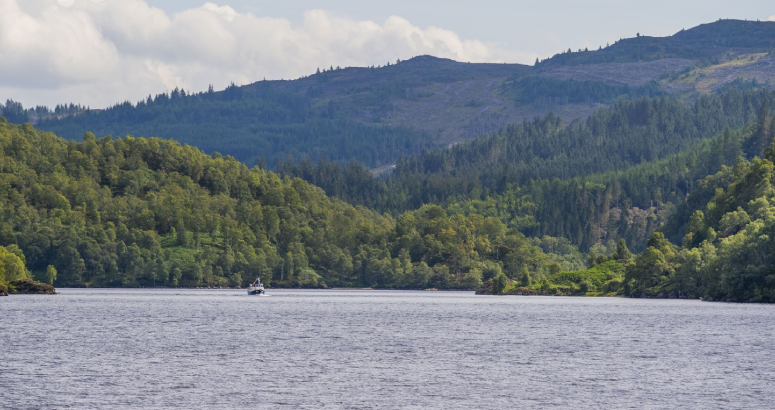Plans to Create One of Europe’s Biggest New Woodlands Gets Green Light at Loch Katrine
23 September 2024
Climate Crisis
Woodland creation and peatland restoration will help lock up carbon in the land surrounding the loch.
A scheme to create one of the biggest new woodlands in Europe at an iconic Scottish loch - and protect water supplies for generations to come - has taken a major step forward.“This 10-year plan sets out a long-term vision which will help secure the resilience and quality of Loch Katrine as a vital water supply into the 22nd Century while also supporting nature, tourism and the rural economy.”
Dr Mark Williams
Head of Sustainability and Climate Change, Scottish Water
The 10-year Land Management Plan (LMP) for Scottish Water’s Loch Katrine estate, developed in partnership with long-term tenant Forestry and Land Scotland (FLS), has been approved by Scottish Forestry - and will see the lands around the loch boost the fight against the climate crisis by locking up more carbon and improving the resilience of the catchment to climate change.
The 8-miles long freshwater loch – which supplies water to 1.3 million people in the Greater Glasgow area and other parts of the Central Belt via infrastructure built largely by Victorian pioneers – is surrounded by 9,500 hectares of land which is occupied and managed by FLS and located in the heart of the Loch Lomond and Trossachs National Park (LLTNP).
Plans for the land at Loch Katrine include the restoration and maintenance of several hundred hectares of peatland across the site, as well as the creation of over 4,600 hectares – the equivalent of more than 6440 football pitches – of native woodland, largely through re-wilding and natural regeneration.
It is anticipated that delivering these actions will see a 40 per cent increase in the status of biodiversity across the site, as well as capturing up to 1 million tonnes of carbon over 60 years.
It is also key in helping to protect the quality and resilience of the water supply at the loch in the face of a changing climate. Restoring natural woodland and encouraging healthy, functioning peatland and moorland will make the landscape more resilient to climate change, helping to stabilise soils, hold more water and slow the runoff from the land.
This results in less organic matter being washed into the loch and on to the water treatment works - a growing issue thanks to more extreme rainfall caused by climate change - and ensures the water can continue to be treated to the high standards customers expect.
Dr Mark Williams, Scottish Water’s Head of Sustainability and Climate Change, said:
“Loch Katrine is a hugely significant site in terms of Scotland’s natural environment, as well as being the basis of an essential service for around a quarter of Scotland’s population.
“It has nationally important peatland, moorland and woodland habitats, which offer many recreational opportunities for visitors and residents alike but which are also vitally important in our work to mitigate the impact of the climate crisis.
“The energy needed to provide essential water and waste water services makes Scottish Water one of the largest single users of electricity in the country, and whilst we are working hard to eliminate emissions across the entirety of our assets, we must also ensure that the woodland, peatland and natural habitats across our landholdings are thriving, able to lock up carbon and support our journey to net zero emissions.”
He added: “By taking a whole-catchment approach, this 10-year plan sets out a long-term vision which will help secure the resilience and quality of Loch Katrine as a vital water supply into the 22nd Century while also supporting nature, tourism and the rural economy.”

Water quality
The plans will help to protect the quality and resilience of the water supply at Loch Katrine.
The site also makes an active contribution to the Great Trossachs Forest – an initiative driven by FLS, Woodland Trust Scotland, Loch Lomond and the Trossachs National Park Authority and the Royal Society for the Protection of Birds (RSPB) that will see a rich and diverse mosaic of habitats full of wildlife stretching 16,500 hectares from Callander in the east to the shores of Loch Lomond in the west.
Carol McGinnes, FLS’ Central Region Manager, said: “It has taken a lot of hard work in this collaborative effort to get the project to this stage. We can now look forward to on-the-ground delivery and making the sorts of changes that will further enhance a very special landscape.”
Simon Jones, Director of Environment and Visitor Services at Loch Lomond and the Trossachs National Park Authority said: “This signals another big step towards the National Park Authority’s goal to reverse the decline in nature by 2030 and see widespread restoration of nature by 2040. The water, peatland and woodland within the Park are undoubtedly our greatest allies in tackling the twin crises of nature loss and the climate emergency.
“As well as our wildlife, the wider natural environment helps to deliver many essential aspects of our lives, from the nutritional value and availability of our food, and the health benefits of good air quality, to the livelihoods of those connected to it. It’s only through partnership working like this, we will achieve the scale of change required to ensure a sustainable future for the National Park.”
Future woodland creation at Loch Katrine will look at encouraging native woodlands, which currently exist at lower levels in the catchment, to expand to sites at a higher elevation – linking woodland from the shores of the loch up into the hills.
Work will also focus on restoring peatland across the site, rewetting, reprofiling and encouraging sphagnum moss to proliferate ensuring it can once again start to retain water and slow surface water run-off into the loch, as well as acting as a carbon sink.
The project will see a variety of habitats of healthy peatland, moorland and woodland which will benefit the diversity of wildlife in the area - including badgers, bats, a huge variety of birds and particularly rare species, such as the Pearl Bordered Fritillary butterfly.
Cameron Maxwell, Perth & Argyll Conservator with Scottish Forestry, said: “We were delighted to approve this ambitious new native woodland creation proposal on the land around Loch Katrine, continuing the expansion of the Great Trossachs Forest National Nature Reserve.”
Carol McGinnes, FLS’ Central Region Manager, said: “It has taken a lot of hard work in this collaborative effort to get the project to this stage. We can now look forward to on-the-ground delivery and making the sorts of changes that will further enhance a very special landscape.”
Simon Jones, Director of Environment and Visitor Services at Loch Lomond and the Trossachs National Park Authority said: “This signals another big step towards the National Park Authority’s goal to reverse the decline in nature by 2030 and see widespread restoration of nature by 2040. The water, peatland and woodland within the Park are undoubtedly our greatest allies in tackling the twin crises of nature loss and the climate emergency.
“As well as our wildlife, the wider natural environment helps to deliver many essential aspects of our lives, from the nutritional value and availability of our food, and the health benefits of good air quality, to the livelihoods of those connected to it. It’s only through partnership working like this, we will achieve the scale of change required to ensure a sustainable future for the National Park.”
Future woodland creation at Loch Katrine will look at encouraging native woodlands, which currently exist at lower levels in the catchment, to expand to sites at a higher elevation – linking woodland from the shores of the loch up into the hills.
Work will also focus on restoring peatland across the site, rewetting, reprofiling and encouraging sphagnum moss to proliferate ensuring it can once again start to retain water and slow surface water run-off into the loch, as well as acting as a carbon sink.
The project will see a variety of habitats of healthy peatland, moorland and woodland which will benefit the diversity of wildlife in the area - including badgers, bats, a huge variety of birds and particularly rare species, such as the Pearl Bordered Fritillary butterfly.
Cameron Maxwell, Perth & Argyll Conservator with Scottish Forestry, said: “We were delighted to approve this ambitious new native woodland creation proposal on the land around Loch Katrine, continuing the expansion of the Great Trossachs Forest National Nature Reserve.”







